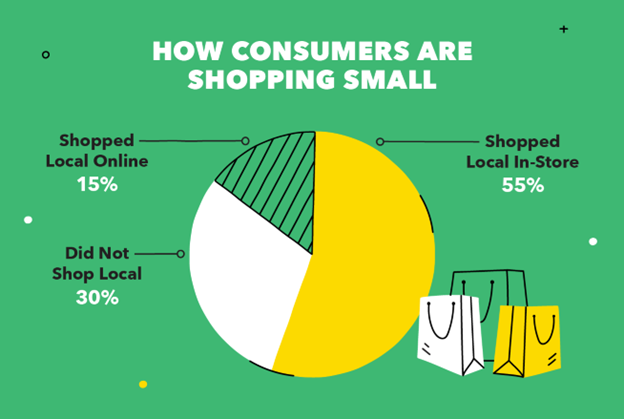How SMBs Can Close The Competitive Gap with Big Business
in Business by Jenna Bunnell

If all you did was watch TV and surf the web all day, you would be forgiven for thinking that large companies and big brands dominate the planet. However, you don’t watch TV and browse the internet all day, right?
SMBs like yours are everywhere. They’re the heart and soul of our daily lives. Recent data shows that small businesses account for 99.9% of all American companies. There are approximately 32.5 million small businesses in the United States alone.
So why does it feel like every time we pop into the real or virtual world, all we come up against are the major brands?
It seems it always comes down to resources like people, time, and most importantly, money. But even if you can’t compete in sheer numbers, you can close the competitive gap through other means.
Ways to close the competitive gap
When it comes to closing the competitive gap, it can seem like the deck is stacked against you. But with so many options available in a digital world, there are plenty of gaps (pun intended) in the strategy of the big brands.
You just need to know where to look—that’s why you’re here isn’t it?
Long-tail keywords for SEO

Image sourced from Semrush
Search engine optimization (SEO) represents an organic and cost-effective way to compete with big companies. The art of SEO used to be shrouded in secrecy, but today, there are many free and low-cost tools available online for small and medium businesses.
SEO tools like Ahrefs, Moz, and Semrush will all get you on the right path. However, you must remember that, to compete with large corporations, you need to think outside the box. Major brands will focus on the obvious and top-end short-tail keywords to reach the widest audience possible.
Rising up those SERPs (Search Engine Results Pages) can prove a daunting task. Instead, focus your attention elsewhere. Long-chain keywords give context and let you focus on more specific search queries. If you get things right, you will find that many of these users will have a greater intent to buy than those using more general search terms.
For example, let’s take hosted VoIP services. Instead of focusing on keywords like “VoIP” and “IP phone” you can traverse into the overlooked long-tail gems. Contextual keywords like “best VoIP services for small businesses in Vermont” will produce less traffic but with a higher conversion rate for the blog posts and landing pages on your website.
Finding which keywords to attack will cost your business very little money. Mostly, it will require a bit of time and effort, but the ROI will help you close the competitive gap like it’s an automatic door!
Shout from the rooftops of social media
In addition to organic SEO efforts, social media platforms represent another channel where SMBs can stand above their larger competition. Firstly, social media is an excellent opportunity for free advertising and raising brand awareness.
Getting the most out of the experience requires active posting and constant interaction with customers, influencers, and other businesses. Tools like Hootsuite and Sprout Social offer affordable ways for your business to track mentions and monitor social media trends.

Free to use image sourced from Unsplash
But even without those apps, you can still expand your reach and gain leads through other means. Consider influencer marketing as a way to appeal to your niche customer segments. You can also create videos and other visual content to be shared on places like Instagram, Youtube, and Facebook.
Making videos entertaining and useful doesn’t come down to things like ad budget and marketing spend. It’s more important to create original content. As a small or medium business, you can more easily put your unique spin or humor into your content.
If you deal with B2B sales, many of the same rules apply. The difference lies with the type of content and what platforms. Writing shareable articles and blog posts on LinkedIn and Twitter is where you will want to focus your efforts.
Improve and innovate
At first glance, the competitive gap between SMBs and large businesses may seem hopeless. They have so much of everything. How can you have any chance in the game?
Well, dig a little deeper, and not everything is as it first appears. One area where you hold the upper hand is business agility. With fewer people involved and fewer hoops to jump through, your business can quickly change things like branding and marketing tactics.
Even better, your company will be more agile in keeping up with market trends. It’s a lot easier to change, revamp, and put out completely new products with fewer processes and gatekeepers in the way.
Use your agility to your advantage by implementing more rapid innovations and product improvements than the competition. Keep an eye on what the top brands are putting into the market—ethically steal their idea and make it even better.
While your larger market rivals are still running down stock from global warehouses, your team will already be releasing a new and improved version!
Focus on your niche
You may have noticed a bit of a theme developing with our tactics on how to close the competitive gap. It comes down to choosing your battles. You don’t have the same resources as the behemoth corporations. You will have to concede in some areas.
It may be a no-brainer, but smaller businesses need to focus on their niche(s). By doing so, you can hone your voice as an authoritative expert within your market. For example, instead of trying to disrupt the risk management industry, get more specific by focusing on something like operational risk management.
Find one or two ways you can outdo large businesses and then run with it. This could be in areas like quality, ease of use, warranties, design, product features, or other unique selling points (USPs).
Once you have identified, build your marketing strategies around your niche USPs and run ahead of the competition.
Build a local community
Going local can have a multi-pronged effect on your business. One, it lets you reach an audience with increased buyer intent. A 2020 survey by Inuit found that 70% of consumers were shopping locally in-person and online.

Image sourced from Intuit
Survey respondents also indicated that their top-three reasons for shopping with local businesses were:
- Keep money local
- Connect with community
- Support local creators
You can also tailor your marketing and SEO efforts to reach consumers looking for local businesses.
That brings us to the second part of going local. It helps you become a bigger part of the community. This lets you join up with other like-minded and local SMBs for mutual benefits. You can partner up to expand your reach.
For example, it’s common for independent craft breweries to produce a beer in collaboration. Once released, this product will bring a cross-awareness of each brand’s customers. It also reinforces the importance of supporting local creators.
Create excellent content
We’ve already emphasized the importance of unique and original content, but we want this point to hit home. SMBs like yours can use a content-marketing strategy to lessen the gap between you and the big “corpos”.
Don’t build a strategy around high volumes of keyword-infested content—let those large businesses have at it! When it comes to content, always focus on quality over quantity. This means gathering the expert voices from your company and letting them put their creative juices online.
A long burn of regular, quality content will always appeal to your target audience more than generic wide-reaching drivel. The beauty of a focus on quality is that it helps you naturally focus on long-tail keywords and your niche (two tactics mentioned above!).
Offer superior personal customer service
We’ve entered an era where consumers expect good customer service from businesses regardless of size. According to Khoros, 68% of customers will spend more money with a brand that understands them and treats them like an individual, while 65% have switched brands due to a poor experience. 83% said good customer service was the most important factor when choosing a brand. With these numbers, it’s clear that superior customer service and support are needed to stay ahead of the competition.

Free to use image sourced from Unsplash
The good news is that there are many business phone system services available for SMBs that won’t break the bank. Many of these platforms offer support for cloud-based contact centers or AI chatbots. These services give you a solution for 24/7 customer support that won’t break the bank.
But the reality may be different. You may find yourself missing the monetary resources for such tools but you haven’t lost the CS battle just yet. What you can offer is local and personalized customer service during your operating hours.
If a customer has a problem with a product, invite them to come on down to the brick-and-mortar location where all can be sorted. In this way, they can meet the person they are talking to on the phone.
And remember, always go out of your way to give excellent customer service. Even if it loses you money this time, it will save you the damage of negative reviews. Reviewtrackers reported that 94% of consumers say a bad review convinced them to avoid a business—that’s really all it takes!
Don’t give up the good fight
There’s plenty of room for SMBs in the market. It just takes a bit of innovation and a can-do attitude. Focus on what makes your business unique, and let your creatives help you shine.
You can also find affordable tools that will level the playing field with your larger competition. The most important things you can do is provide unique, local experiences and freely give high-quality content to your audience.
Those in the know will flock to your business and ditch the big brands like the plague.




